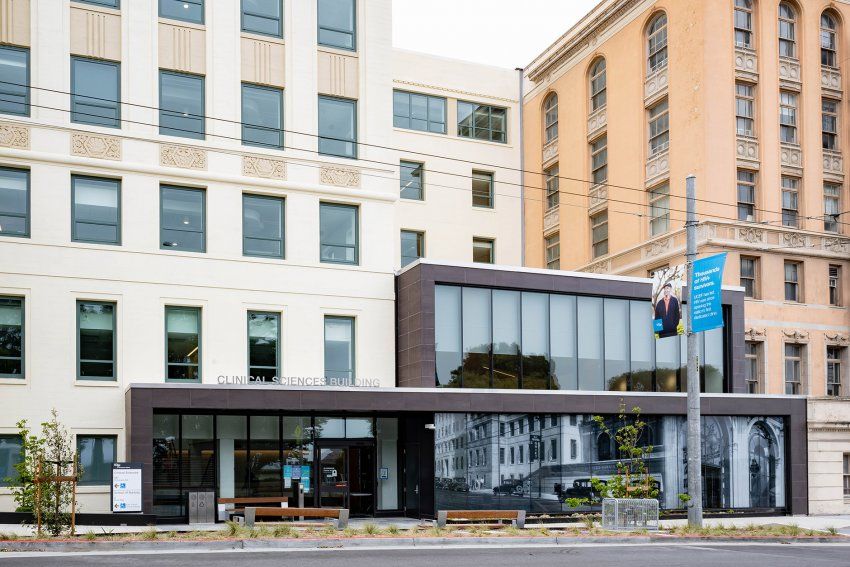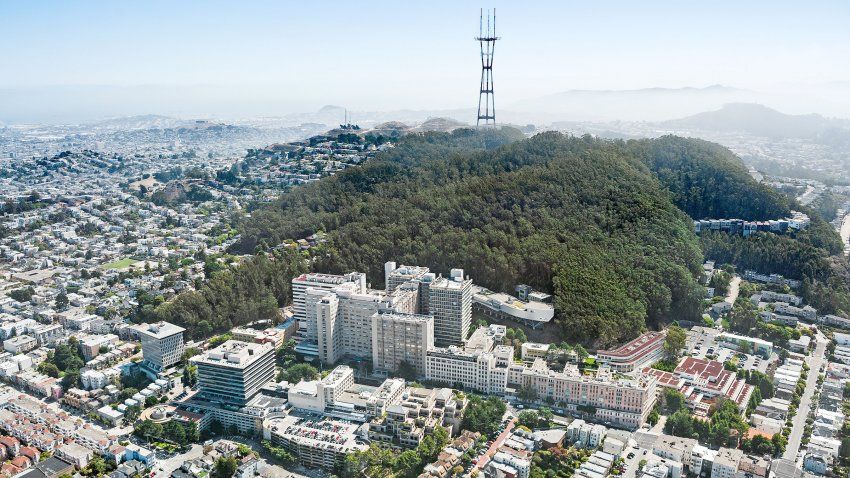UCSF Seismic Safety Review Finds Most Buildings Earthquake Resilient

In February, UCSF reopened its 88-year-old Clinical Sciences Building after renovating it to meet current seismic safety requirements and modernizing spaces to better support teaching and research. Photo by Susan Merrell
The latest seismic review of UC San Francisco-owned buildings finds that most are seismically resilient to withstand a major earthquake, according to an independent team of leading structural and geotechnical engineers.
Committed to the health and safety of its community, the University of California Office of the President (UCOP) voluntarily initiated this review to assess how buildings across the 10-campus system will perform during an earthquake.
The UC Board of Regents’ Finance and Capital Strategies Committee will discuss UC’s seismic safety program Sept. 29.
UC uses a rating system for building resiliency ranging from good to bad, or I to VII, depending on their expected performance in an earthquake. Buildings that have been rated a V, VI and VII require further action. Of the more than 6,000 buildings evaluated, about 70 percent are compliant with UC’s strict seismic safety policy, which exceeds standards of other state institutions.
UCSF has increased its percentage of seismically compliant building space from 33 percent in 2000 to 66 percent in 2021 by investing about $1 billion over the past decade in new construction, seismic retrofitting, and vacating and demolishing buildings that do not meet UC’s seismic standards.
“With the safety of our UCSF community in mind, we are continually working to improve the seismic resiliency of our existing buildings based on new insights and discoveries in seismology and structural and geotechnical engineering,” says UCSF Chancellor Sam Hawgood, MBBS. “In addition to retrofitting and renovating our existing buildings, we are building new facilities that meet today’s seismic resiliency standards.”
Using Latest Seismic Standards
New seismic safety standards and changes to building codes, prompted UCOP to reassess its building inventory across the UC system. In 2018, UCOP, UCSF and the other campuses initiated seismic reevaluations of UC facilities to comply with UC seismic safety policy, which covers all University facilities within California, with a few exceptions. This policy does not apply to buildings under the regulatory authority of the Office of Statewide Health Planning and Development (OSHPD). As such, UCSF’s hospital facilities were not part of this seismic review.
UCSF’s independent team of engineers, called the UCSF Seismic Review Committee, systematically and scientifically evaluated the University’s owned buildings using the latest standards set by the American Society of Civil Engineers and UC’s seismic safety policy. UCSF released its first round of seismic review reports on Sept. 20, 2019 and this second round completes the review of its owned buildings. Read the seismic safety reports here.
Since 2011, UCSF has contracted with the SRC to peer review the structural design of all new buildings and seismic renovations to existing buildings. The SRC also advises UCSF on ways to make compliant buildings safer and more resilient, and how to establish priorities for seismic compliance.
Priorities for seismic remediation are based on a building’s age, use, population size, structural resiliency, geology and other factors. The SRC considers all these factors to advise UCSF leaders on the course of action – whether to renovate, temporarily or permanently vacate, or demolish buildings.
Maryann Phipps, chair of the UCSF Seismic Review Committee who brings more than 30 years of experience evaluating, designing and renovating buildings in California, appreciates how UCSF is “continually reducing its seismic risk.”
“The evaluation process has helped foster and reinforce a culture of seismic safety throughout UCSF,” Phipps says. “By identifying potential seismic risks and addressing deficiencies, UCSF is better able to serve the community and all its stakeholders after a large earthquake.”
Modernizing Parnassus Heights
UCSF’s 30-year comprehensive plan to modernize its oldest campus at Parnassus Heights aims to retrofit seismically deficient buildings or replace them altogether with new facilities that better support cutting-edge care delivery, scientific research and graduate-level education.
“We are continually working to improve the seismic safety and environmental sustainability of our buildings,” says Campus Architect Alicia Murasaki, assistant vice chancellor of Campus Planning. “Despite the financial challenges brought on by the pandemic over the past year, we were able to move forward on several projects.”

The UCSF Parnassus Heights campus.
In February, UCSF reopened its 88-year-old Clinical Sciences Building after renovating it to meet current seismic safety requirements and modernizing spaces to better support teaching and research. The project also connected Parnassus Avenue with the new Holly Smith, MD, Gateway, named after the late physician-scientist Lloyd Hollingsworth “Holly” Smith.
A key part of the revitalization of the Parnassus Heights campus is building a new hospital to meet the seismic safety requirements of Senate Bill (SB) 1953 by 2030 as regulated by OSHPD. This new hospital will enable UCSF to meet increasing demand of an aging population who come to UCSF for its high-quality, complex care. The current hospital at UCSF Helen Diller Medical Center at Parnassus Heights is regularly operating over capacity and must turn away patients who are referred to UCSF due to lack of beds.
UCSF received a $500 million commitment from the Helen Diller Foundation to help finance the planning, design, and construction of this new hospital building. As part of this project, UCSF will seismically retrofit and partially renovate Moffitt Hospital. UCSF’s three new hospitals at Mission Bay, opened in 2015, meet the today’s seismic standards and the 2030 state building code requirements.
The revitalization plan for Parnassus Heights also calls for constructing a new Research and Academic Building to replace UC Hall, which was built in 1917 as UC’s first hospital. This new research and academic building will include replacing space from the School of Nursing building, which has been identified as a priority for demolition with a seismic rating of VI.
Murasaki and others from the UCSF Real Estate team have communicated UCSF’s plans for addressing seismic safety through the UCSF Space Committee and in meetings with deans. “We are available to meet with members of the community who have questions about our seismic safety program,” she says.
Financing Building Renovations
Once additional seismic evaluations are completed, UCSF and UC system leaders will collaborate with state agencies and other organizations to identify and access funding sources to finance more improvements as they work to meet UC’s seismic policy deadline of Dec. 31, 2030.
UCSF’s budget for upcoming projects, and for which funding has been identified, totals about $900 million, including about $296 million for seismic mitigation, according to Afsaneh Ahmadi, the designated campus building official for UCSF Real Estate.
More study is needed to determine the scope and cost of renovating buildings not currently funded in the capital plan. Total costs to address seismic compliance, other code issues, deferred maintenance and programmatic needs at UCSF are estimated to be upwards of $3.3 billion – with seismic improvements representing about half these costs, according to Ahmadi.
The current anticipated total capital need to address seismic improvement projects across the UC system is $20.1 billion, of which about 10 percent is identified as having or proposing a funding source. The remaining 90 percent of projects do not have funding sources identified and capital needs exceed the UC system’s current funding and debt capacity.
Securing finances to finance these capital improvements will be an ongoing effort that will require state leaders and California voters to understand the importance of investing in UC’s buildings to ensure they are seismically resilient and safe for the UC community.
Questions about UCSF’s seismic safety program may directed via email to [email protected].